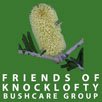

 |
Friends of Knocklofty |  |
|
| BUSHCARE GROUP | |||
|
Dodonea viscosa subsp. spatulata
ViewFlora Descriptions and images |
Knocklofty Reserve Flora - DDaviesia sejugata, common name "Leafy spiky bitterpea", is not indigenous to Knocklofty Reserve. It has been planted under the sandstone cliffs along the Main Trail near the Forest Road carpark entrance. It is a small shrub with sparse, spiky leaves and yellow pea flower with red throats in spring. In home gardens it prefers well mulched, moist soils in full to part sun. It has broader leaves and fewer spikes than D. ulicifolia which grow naturally throughout the Reserve.
Daviesia ulicifolia, common name "Yellow spiky bitter-pea", is an open, prickly, woody shrub growing 0.5 to 2m high by 0.5 to 1.5m wide. The yellow/brown, spring, pea flowers appear singly or in clusters along the stems, especially toward the ends. This prickly plant is sometimes confused with the woody weed "Gorse" (Ulex europaeus) but "Gorse" has hairy stems and leaves whereas D. ulicifolia has smooth stems and leaves. It grows throughout the sunnier areas of the Reserve especially down the Mt Wellington side of the Aurora wayleave from the summit. In home gardens it requires well drained soils in part/full sun and requires prune hard after flowering for shape.
Dillwynia cinerascens, common name "Grey Parrotpea", is a heathland species found in the sandstone areas of Knocklofty Reserve such as along the Corby Avenue Track and SE of the Forest Road carpark. It is a small, slender, hairy shrub, growing 0.3 to 0.8m high by 0.3 to 0.9m wide with yellow/orange terminal flower clusters in winter and spring. It prefers well drained soils in part sun.
Diplarrena moraea, common name "White flag iris", is a tufted, spreading herb that grow 0.3 to 1m high by 0.5 to 1m wide. The white, multiple, 'one-day' flowers appear in spring through summer on tall stems. This lovely species prefers moist, well drained, sunny soils and is frost hardy. It can make a good pot plant.
Diuris chryseopsis, common name Large Golden Moths, has been found in the grassy areas under Eucalyptus trees in the Mt Stuart end of the Knocklofty reserve. The one to three bright golden yellow to yellow -orange flowers per stem with dark strips on the dorsal sepal (top flower part) appear in summer above a tuft of two to four narrow leaves. It prefers sandy or sandy clay moist well drained soils.
Dodonea viscosa subsp. spatulata, common name "Broadleaf hopbush", grows throughout the Knocklofty Reserve, mainly on dolerite soils and good examples of the species may be seen up the Mt Stuart Road to the carpark, up the Mt Stuart Track steps and along the Fiona Allan Track. It grows 2 to 6m high by 2 to 3.5m wide, has sticky green leaves and small clusters of white flowers on the ends of the stems in spring. The clusters of fruit, each of which has 3 or 4 wings, can be very attractive, especially the bright red form. It can tolerate periods of dryness, light frosts and coastal conditions. In the home garden it can make a good hedge plant if regularly lightly pruned, and it prefers good drainage and full sun.
Drosera peltata, common name "Pale Sundew", is found in many places in the Knocklofty Reserve such as on the wayleave north of Trig Hill and in the sandy heath south east of the Forest Road carpark. The white or pale pink flowers appear on the tips of the single stem above glandular leaves and a round leaf basal rosette in spring through to summer. If grown in the home garden, it requires constant moisture in the spring and summer, but dry conditions in the autumn and winter. It could be grown as an interesting carnivorous pot plant.
|